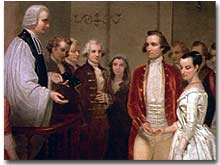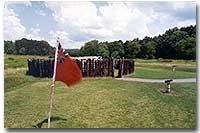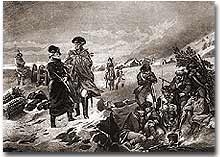17b. The Force of Personality and Military Command

The Marriage of Washington to Martha Custis, by Junius Brutus Stears, (1849). Martha's 2 children from her first marriage to Daniel Parke Custis are standing with other guests in the background.
George Washington was a serious man.
He carried himself with a grave dignity often described as aloofness. Quite the opposite of being an informal joker, Washington held people at a distance. A central part of his personality included strong self-control that avoided excessive camaraderie. Surely, his long military service played a significant role molding this character. First as a militia officer on the Virginia frontier preceding and during the French and Indian War (1754-58) and then again as the commander of the Continental Army (1775-83), Washington believed that familiarity could weaken the respect an officer needed for effective command.

The Battle of Fort Necessity was the first major military action in George Washington's career. The site has been designated a National Battlefield.
During his first military term, Washington had been sent west by the Governor of Virginia to try to keep the French out of newly claimed Virginia land. Such an expedition required great skill not only with the French and difficult frontier conditions, but also an awareness of the importance of Native Americans in shaping the balance of power in the contested region. The youthful Washington, basically in his first command, clearly lacked the necessary experience. His rash killing of members of a French diplomatic mission and then his defeat at the Battle of Fort Necessity in July 1754 made for a disastrous start to the French and Indian War.
Matters were made worse by the sharp divisions that separated Virginia militia traditions from those of the regular British Army. Where Washington naively thought he had performed rather well and hoped to receive a commission to become a full-fledged British officer, the British saw him as an incompetent provincial officer who lacked the aristocratic birth, the wealth, and the skill required of a proper British officer.

"Discipline is the soul of an army. It makes small numbers formidable; procures success to the weak, and esteem to all." -George Washington, 1759, in a letter to the captains of the Virginia Regiments during the French and Indian War. This image is a copy of an engraving by H.B. Hall after Alonzo Chappel, showing Washington and Lafayette at Valley Forge during the winter of 1777-78.
Washington's experience in the French and Indian War later included some bright moments and he became Virginia's most celebrated hero of the war thanks in large part to several remarkable escapes from heavy gunfire. Washington's leading knowledge of frontier conditions and enormous personal energy had made him a charismatic figure. But overall his leadership in this first long war was badly flawed.
When Washington returned to active military leadership at the start of the Revolutionary War in 1775, he again faced enormous challenges. But he also had matured in the decade and a half between conflicts and had developed a much more sophisticated understanding of the political dimension of military leadership. Washington had married the wealthy widow Martha Custis in 1759 and with her money had expanded Mt. Vernon and turned it into an impressive plantation. Furthermore, he had served several terms in the Virginia legislature and had become a much more experienced leader. Although Washington's record as a military strategist is sometimes questioned, he did score a handful of absolutely critical victories in the Revolutionary War.
Washington's key strategic insight was to realize that independence depended more on keeping an army in the field than on winning major battles. In spite of a persistent lack of adequate funding from the Congress and in the face of growing conflict from his own officers and enlisted men, Washington held the army together through a skilled combination of discipline and personal example. The army's survival at Valley Forge in the harsh winter of 1777-1778 is the classic example.
Washington's greatest contribution to the Revolutionary War, however, was his consistent acknowledgment of the preeminence of civilian leadership. When other military leaders might have been tempted to seize political power and rule as a more efficient strong man, Washington's respect for the preeminence of civil authority over martial authority kept the republican experiment alive.






